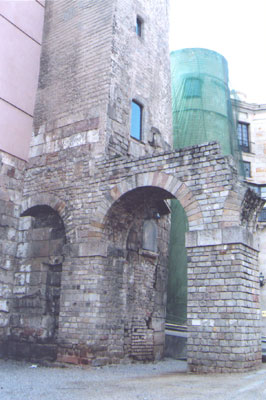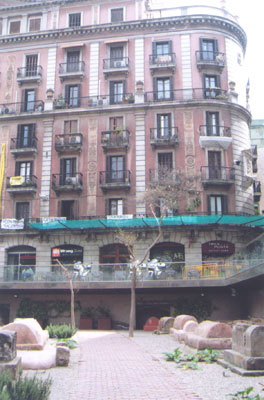Roman Barcino
This item appears on page 66 of the March 2011 issue.
by Julie Skurdenis
In the Barri Gòtic, one of Barcelona’s oldest quarters, there is a lovely small square called the Plaça del Rei (King’s Square). Dark, narrow streets lead to the square, hidden away in the middle of the old quarter. Minutes away is a major thoroughfare, but you wouldn’t know it standing there surrounded by medieval stone buildings.
Barcelonans pass by, striding briskly. Tourists stroll through at a more leisurely pace, slowing down to admire the old buildings. Very few — locals or tourists — realize that just beneath their feet lies another city 2,000 years old.
Iberians, a non-Indo-European culture, occupied this area of Spain from the sixth to second centuries BC. Roman troops arrived at the end of the third century BC, conquering and Romanizing the Iberians. About 15 BC, during the reign of Emperor Caesar Augustus, the Romans built a city they called Colonia Julia Augusta Faventia Paterna Barcino. Barcino, for short. It is the ruins of this city that lie just 16 feet beneath the Plaça del Rei.
Roman city
Roman Barcino was enclosed by a sturdy defense wall with four gates. As in most Roman cities, Barcino had a forum where political, religious and business affairs were centered. There were also temples, public baths and villas within the walls. Outside the walls were aqueducts as well as cemeteries lining the roads leading to other parts of the Roman Empire.
What is interesting about the Barcino ruins is that there are no monumental temples or triumphal arches but, rather, the remnants of everyday life of 20 centuries ago. What has been excavated is a commercial area of workshops and factories, giving visitors a glimpse of the day-to-day life of Romans living there.
Visitors enter the ruins through the City History Museum at one corner of the Plaça and descend to follow a self-guided trail through workaday Barcino, passing a fullonica (laundry), tinctoria (dye shop for cloth and clothing), cetaria (factory for salting fish and making fish-based sauces) and, most interesting, a wine-making establishment complete with enormous wine storage jugs.
The workplaces are fairly small in size and stand close beside each other along what once were the streets of Barcino. Later on in Barcino’s history, as Christianity took root and spread, a church complex was built in the fourth century AD not far from the wine makers and, later, in the sixth century AD, a Visigoth-era church.
A Visigoth palace built in the sixth century AD was overlaid three centuries later by a Carolingian-era palace, itself becoming the foundation of a count’s palace in the 12th century.
A medieval palace that was moved to the Plaça del Rei in 1931 to save it from road construction served as the catalyst for the discovery and subsequent excavations of Roman Barcino.
Hours for the Barcino ruins are as follows: from October to March, 10 to 2 and 4 to 7 Tuesday to Saturday and 10 to 8 Sunday, and from April to September, 10 to 8 Tuesday to Sunday. The admission charge is €7 (about $10).
Other Roman ruins
Not all of Barcelona’s archaeological riches lie underground. Large sections of Roman wall and some towers can be seen throughout the Barri Gòtic. There’s one stretch on Plaça Ramon Berenguer where 14th-century walls lie on top of earlier Roman walls.
The City History Museum publishes an excellent pamphlet (available free), “Barcino, a Tour Through Roman Barcelona,” that guides walkers to the most significant remaining sections of walls and towers.
In the Plaça Nova, close to the Cathedral, is a double reward: two semicircular towers guarding what once was one of the city gates and, next to it, remnants of an aqueduct that carried water into the Roman city.
On Carrer Paradis, behind the Cathedral, there is a portion of the first-century-AD Roman temple that once stood in the Roman Forum. It’s presently closed for restoration.
One final “do not miss” for those interested in Barcelona’s Roman past is the Plaça Villa de Madrid, a secluded square also in the Barri Gòtic. Below street level, but open to the air and visible, is a section of the ancient Roman road and, lining it, modest stone tombs. Barcino’s departed or their ashes were laid to rest in these tombs along the roads leading to the city where they had spent their lives.
Today’s Barcelona
Roman ruins were just one highlight of our 16-night stay in Barcelona in April 2010. Here are some favorites my husband and I would recommend, even if you have only a few days in the city: stroll through the Barri Gòtic, the old quarter, stopping along the way to see the Cathedral with its resident geese who live in a shady cloister; ramble along La Rambla, Barcelona’s pedestrian boulevard with outdoor cafés, restaurants, street artists, living “statues” and lots of people out for a leisurely paseo, and see as many of Antoni Gaudí’s buildings as you can possibly squeeze in.
Antoni Gaudí (1852-1926) was an architectural genius, one of the primary exponents of the Modernista movement of the late 19th and early 20th centuries. He created buildings and parks, combining technical skill, imagination and a sense of lightheartedness.
Fortunately, Barcelona is rich in his architecture: La Pedrera, Casa Battló, Palau Güell, Parc Güell and Sagrada Familia. This last is the fantastical Gaudi church that has been “in the works” since 1882, with completion anticipated around 2030.
Barcelona has dozens of museums. Our favorites included the National Museum of Catalan Art for its outstanding Romanesque art collection, the Picasso Museum, the Joan Miró Foundation (Miró was Catalan) and the Barbier-Mueller Museum of Pre-Columbian Art, exhibiting Inca, Maya and Aztec art objects.
Finally, we love visiting Poble Espanyol, a re-creation of famous buildings from all parts of Spain combined with cafés and handicraft shops (don’t miss the glassblower). We visit on every trip to Barcelona. Some guidebooks claim it’s tacky. Don’t pay attention to them. Just go and enjoy yourself.
If you go…
I highly recommend two day-long excursions: Montserrat and Sitges (€69, about $94) and Girona and Dalí’s Figueres (€71). Both trips are offered daily, except Monday, by Catalunya Bus Turistic, which has other day tours as well.
There are also five excellent walking tours offered by Barcelona Walking Tours (titled Barri Gòtic, Picasso, Modernisme, Marina and Gourmet). Each lasts about two hours and costs between €12.50 and €19.
For information for either the day excursions or the walks, call 34 932 853 832 or e-mail info@barcelona turisme.com.


